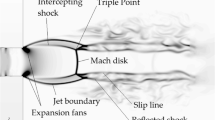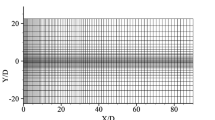Abstract
We present the development of an experimentally validated computational fluid dynamics model for liquid micro jets. Such jets are produced by focusing hydrodynamic momentum from a co-flowing sheath of gas on a liquid stream in a nozzle. The numerical model based on laminar two-phase, Newtonian, compressible Navier–Stokes equations is solved with finite volume method, where the phase interface is treated by the volume of fluid approach. A mixture model of the two-phase system is solved in axisymmetry using ~ 300,000 finite volumes, while ensuring mesh independence with the finite volumes of the size 0.25 µm in the vicinity of the jet and drops. The numerical model is evaluated by comparing jet diameters and jet lengths obtained experimentally and from scaling analysis. They are not affected by the strong temperature and viscosity changes in the focusing gas while expanding at nozzle outlet. A range of gas and liquid-operating parameters is investigated numerically to understand their influence on the jet performance. The study is performed for gas and liquid Reynolds numbers in the range 17–1222 and 110–215, and Weber numbers in the range 3–320, respectively. A reasonably good agreement between experimental and scaling results is found for the range of operating parameters never tackled before. This study provides a basis for further computational designs as well as adjustments of the operating conditions for specific liquids and gases.





















Similar content being viewed by others
References
Ahrens J, Geveci B, Law C (2005) ParaView: An end-user tool for large-data visualization. Visualization Handbook. Elsevier, New York, pp 717–731
Berberović E (2010) Investigation of free-surface flow associated with drop impact: numerical simulations and theoretical modeling. Technical University, Darmstadt
Beyerlein KR, Adriano L, Heymann M et al (2015) Ceramic micro-injection molded nozzles for serial femtosecond crystallography sample delivery. Rev Sci Instrum 86:125104. https://doi.org/10.1063/1.4936843
Brackbill JU, Kothe DB, Zemach C (1992) A continuum method for modeling surface tension. J Comput Phys 100:335–354. https://doi.org/10.1016/0021-9991(92)90240-Y
Celik I, Karatekin O (1997) Numerical experiments on application of Richardson extrapolation with nonuniform grids. J Fluids Eng 119:584–590. https://doi.org/10.1115/1.2819284
Chapman HN, Fromme P, Barty A et al (2011) Femtosecond X-ray protein nanocrystallography. Nature 470:73–77. https://doi.org/10.1038/nature09750
Chen YP, Wu LY, Zhang L (2013) Emulsion droplet formation in coflowing liquid streams. Phys Rev E 87:013002
Chen YP, Wu LY, Zhang L (2015) Dynamic behaviors of double emulsion formation in a flow-focusing device. Int J Heat Mass Transf 82:42–50
Courant R, Friedrichs K, Lewy H (1967) On the partial difference equations of mathematical physics. IBM J Res Dev 11:215–234. https://doi.org/10.1147/rd.112.0215
Cruz-Mazo F, Montanero JM, Gañán-Calvo AM (2016) Monosized dripping mode of axisymmetric flow focusing. Phys Rev E 94:053122. https://doi.org/10.1103/PhysRevE.94.053122
Datta BN (2010) Numerical linear algebra and applications. SIAM, Philadelphia
DePonte DP, Weierstall U, Schmidt K et al (2008) Gas dynamic virtual nozzle for generation of microscopic droplet streams. J Phys Appl Phys 41:195505. https://doi.org/10.1088/0022-3727/41/19/195505
Dupin MM, Halliday I, Care CM (2006) Simulation of a microfluidic flow-focusing device. Phys Rev E 73:055701. https://doi.org/10.1103/PhysRevE.73.055701
Erickson D (2005) Towards numerical prototyping of labs-on-chip: modeling for integrated microfluidic devices. Microfluid Nanofluidics 1:301–318. https://doi.org/10.1007/s10404-005-0041-z
Eroglu H, Chigier N (1991) Wave characteristics of liquid jets from airblast coaxial atomizers. At Sprays 1:349–366. https://doi.org/10.1615/AtomizSpr.v1.i4.10
Gañán-Calvo AM (1998) Generation of steady liquid microthreads and micron-sized monodisperse sprays in gas streams. Phys Rev Lett 80:285–288. https://doi.org/10.1103/PhysRevLett.80.285
Gañán-Calvo AM (2005) Enhanced liquid atomization: From flow-focusing to flow-blurring. Appl Phys Lett 86:1–3. https://doi.org/10.1063/1.1931057
Gañán-Calvo AM, DePonte DP, Herrada MA et al (2010) Liquid capillary micro/nanojets in free-jet expansion. Small 6:822–824. https://doi.org/10.1002/smll.200901786
Glimm J, Grove J, Lindquist B et al (1988) The bifurcation of tracked scalar waves. SIAM J Sci Stat Comput 9:61–79. https://doi.org/10.1137/0909006
Gordillo JM, Pérez-Saborid M, Gañán-Calvo AM (2001) Linear stability of co-flowing liquid–gas jets. J Fluid Mech 448:23–51. https://doi.org/10.1017/S0022112001005729
Green DW, Perry RH (2008) Perry’s chemical engineer’s handbook, 8th edn. McGraw-Hill, New York
Harlow FH, Welch JE (1965) Numerical calculation of time dependent viscous incompressible flow of fluid with free surface. Phys Fluids 8:2182. https://doi.org/10.1063/1.1761178
Herrada MA, Gañán-Calvo AM, Ojeda-Monge A et al (2008) Liquid flow focused by a gas: jetting, dripping, and recirculation. Phys Rev E 78:036323. https://doi.org/10.1103/PhysRevE.78.036323
Herrada MA, Montanero JM, Ferrera C, Ganan-Calvo AM (2010) Analysis of the dripping–jetting transition in compound capillary jets. J Fluid Mech 649:523–536
Hirt CW, Nichols BD (1981) Volume of fluid (VOF) method for the dynamics of free boundaries. J Comput Phys 39:201–225. https://doi.org/10.1016/0021-9991(81)90145-5
Hunter JD (2007) Matplotlib: a 2D graphics environment. Comput Sci Eng 9:90–95. https://doi.org/10.1109/MCSE.2007.55
Issa RI (1986) Solution of the implicitly discretised fluid flow equations by operator-splitting. J Comput Phys 62:40–65. https://doi.org/10.1016/0021-9991(86)90099-9
Kim YJ, You-Jae, Han JG (2004) Numerical analysis of flow characteristics of an atmospheric plasma torch. Nice, France
Lasheras JC, Villermaux E, Hopfinger EJ (1998) Break-up and atomization of a round water jet by a high-speed annular air jet. J Fluid Mech 357:351–379. https://doi.org/10.1017/S0022112097008070
Leroux B, Delabroy O, Lacas F (2007) Experimental study of coaxial atomizers scaling. Part 1: Dense core zone. At Sprays 17:381–407. https://doi.org/10.1615/AtomizSpr.v17.i5.10
LeVeque RJ (2002) Finite volume methods for hyperbolic problems. Cambridge University Press, Cambridge
Liu XD, Zhang CB, Deng ZL, Chen YP (2016) Bubble breakup in a microfluidic T-junction. Sci Bull 61:811–824
Liu XD, Wu LY, Zhao YJ, Chen YP (2017) Study of compound drop formation in axisymmetric microfluidic devices with different geometries. Colloids Surf Physicochem Eng Asp 533:87–98
Marmottant P, Villermaux E (2004) On spray formation. J Fluid Mech 498:73–111. https://doi.org/10.1017/S0022112003006529
Moukalled F, Mangani L, Darwish M (2016) The finite volume method in computational fluid dynamics: an advanced introduction with OpenFOAM and Matlab. Springer, Berlin
Müller T, Sänger A, Habisreuther P et al (2016) Simulation of the primary breakup of a high-viscosity liquid jet by a coaxial annular gas flow. Int J Multiph Flow 87:212–228. https://doi.org/10.1016/j.ijmultiphaseflow.2016.09.008
Nelson G, Kirian RA, Weierstall U et al (2016) Three-dimensional-printed gas dynamic virtual nozzles for X-ray laser sample delivery. Opt Express 24:11515. https://doi.org/10.1364/OE.24.011515
Oberthuer D, Knoška J, Wiedorn MO et al (2017) Double-flow focused liquid injector for efficient serial femtosecond crystallography. Sci Rep 7:44628. https://doi.org/10.1038/srep44628
Osher S, Sethian JA (1988) Fronts propagating with curvature-dependent speed: algorithms based on Hamilton–Jacobi formulations. J Comput Phys 79:12–49. https://doi.org/10.1016/0021-9991(88)90002-2
Patankar SV (1980) Numerical heat transfer and fluid flow. CRC Press, Florida
Patankar SV, Spalding DB (1972) A calculation procedure for heat, mass and momentum transfer in three-dimensional parabolic flows. Int J Heat Mass Transf 15:1787–1806. https://doi.org/10.1016/0017-9310(72)90054-3
Piotter V, Klein A, Plewa K et al (2017) Development of a ceramic injection molding process for liquid jet nozzles to be applied for X-ray free-electron lasers. Microsyst Technol. https://doi.org/10.1007/s00542-017-3493-7
Popinet S (2010) Gerris flow solver. http://gfs.sourceforge.net/wiki/index.php/Main_Page. Accessed 7 Oct 2010
Porcheron E, Carreau J, Visage LD, Roger F (2002) Effect of injection gas density on coaxial liquid jet atomization. At Sprays 12:209–227. https://doi.org/10.1615/AtomizSpr.v12.i123.110
Roache PJ (1994) Perspective: a method for uniform reporting of grid refinement studies. J Fluids Eng 116:405–413. https://doi.org/10.1115/1.2910291
Ryskin G, Leal LG (1984) Numerical solution of free-boundary problems in fluid mechanics. Part 1. The finite-difference technique. J Fluid Mech 148:1. https://doi.org/10.1017/S0022112084002214
Si T, Li F, Yin X-Y, Yin X-Z (2009) Modes in flow focusing and instability of coaxial liquid–gas jets. J Fluid Mech 629:1. https://doi.org/10.1017/S0022112009006211
Steinbach I, Pezzolla F, Nestler B et al (1996) A phase field concept for multiphase systems. Phys Nonlinear Phenom 94:135–147. https://doi.org/10.1016/0167-2789(95)00298-7
Sutherland W (1893) The viscosity of gases and molecular force. Philos Mag S507–S531
Takagi S, Matsumoto Y, Huang H (1997) Numerical analysis of a single rising bubble using boundary-fitted coordinate system. JSME Int J Ser B 40:42–50. https://doi.org/10.1299/jsmeb.40.42
Ubbink O, Issa RI (1999) A method for capturing sharp fluid interfaces on arbitrary meshes. J Comput Phys 153:26–50. https://doi.org/10.1006/jcph.1999.6276
Unverdi SO, Tryggvason G (1992) A front-tracking method for viscous, incompressible, multi-fluid flows. J Comput Phys 100:25–37. https://doi.org/10.1016/0021-9991(92)90307-K
Utada AS, Fernandez-Nieves A, Stone HA, Weitz DA (2007) Dripping to jetting transitions in coflowing liquid streams. Phys Rev Lett 99:094502. https://doi.org/10.1103/PhysRevLett.99.094502
van Leer B (1979) Towards the ultimate conservative difference scheme. V. A second-order sequel to Godunov’s method. J Comput Phys 32:101–136. https://doi.org/10.1016/0021-9991(79)90145-1
Vega EJ, Montanero JM, Herrada MA, Gañán-Calvo AM (2010) Global and local instability of flow focusing: the influence of the geometry. Phys Fluids 22:1–10. https://doi.org/10.1063/1.3450321
Weller HG (2008) A new approach to VOF-based interface capturing methods for incompressible and compressible Flow. Tech Rep 13
Weller HG, Tabor G, Jasak H, Fureby C (1998) A tensorial approach to computational continuum mechanics using object-oriented techniques. Comput Phys 12:620. https://doi.org/10.1063/1.168744
Wu L, Liu X, Zhao Y, Chen Y (2017) Role of local geometry on droplet formation in axisymmetric microfluidics. Chem Eng Sci 163:56–67. https://doi.org/10.1016/j.ces.2017.01.022
Zahoor R, Bajt S, Šarler B (2018a) Numerical investigation on influence of focusing gas type on liquid micro-jet characteristics. Int J Hydromechatronics 1:222–237. https://doi.org/10.1504/IJHM.2018.10014046
Zahoor R, Bajt S, Šarler B (2018b) Influence of gas dynamic virtual nozzle geometry micro-jet characteristics. Int J Multiph Flow 104:152–165. https://doi.org/10.1016/j.ijmultiphaseflow.2018.03.003
Zhao H, Liu HF, Xu JL et al (2012) Breakup and atomization of a round coal water slurry jet by an annular air jet. Chem Eng Sci 78:63–74. https://doi.org/10.1016/j.ces.2012.05.007
Acknowledgements
The authors would like to thank Henry Chapman (CFEL-DESY, Univ. of Hamburg, Center for Ultrafast Imaging) and Kenneth Beyerlein (CFEL-DESY) for fruitful discussions, Fabian Wilde and Jörg U. Hammel (Helmholtz-Zentrum Geesthacht, Germany) for X-ray projection image and Luigi Adriano (DESY) for technical support.
Funding
Funding for this research is provided by Centre of Free Electron Laser (CFEL) under project: Innovative methods for imaging with the use of X-ray free electron laser (XFEL) and synchrotron sources: simulation of gas-focused microjets, by the Helmholtz Association through program-oriented funds, and Slovenian Grant Agency (ARRS) within Program Group P2-0162 and Project J2-7384. The computations were performed on resources at DESY, Hamburg, Faculty of Mechanical Engineering, University of Ljubljana, and Institute of Metals and Technology, Ljubljana.
Author information
Authors and Affiliations
Corresponding author
Additional information
Publisher’s Note
Springer Nature remains neutral with regard to jurisdictional claims in published maps and institutional affiliations.
Appendix
Appendix
The Mach number Ma2 at axial position \({z_4}\) along the nozzle axis is calculated from
where \({A_{{\text{g1}}}}\) and \({A_{{\text{g}}2}}\) represent the cross-sectional area at the gas inlet axial position \({z_1}\) and at axial position \({z_4}\) along the nozzle axis. \(\gamma ={{{c_{\text{p}}}} \mathord{\left/ {\vphantom {{{c_{\text{p}}}} {{c_{\text{v}}}}}} \right. \kern-0pt} {{c_{\text{v}}}}}\) is the ratio of specific heats at constant pressure and constant volume. The pressure at any location \({p_{2,{\text{g}}}}\) can be calculated, with given inlet gas pressure \({p_{{\text{inlet}},{\text{g}}}}\) as
As from experimental data the pressure is known at a distance 1.5 m upstream, \({p_{{\text{inlet}},{\text{g}}}}\) is estimated by performing single-phase compressible simulations in such a way that pressure is adjusted at inlet until an experimentally reported gas flow rate is measured at the nozzle’s gas inlet.
Rights and permissions
About this article
Cite this article
Zahoor, R., Belšak, G., Bajt, S. et al. Simulation of liquid micro-jet in free expanding high-speed co-flowing gas streams. Microfluid Nanofluid 22, 87 (2018). https://doi.org/10.1007/s10404-018-2110-0
Received:
Accepted:
Published:
DOI: https://doi.org/10.1007/s10404-018-2110-0




